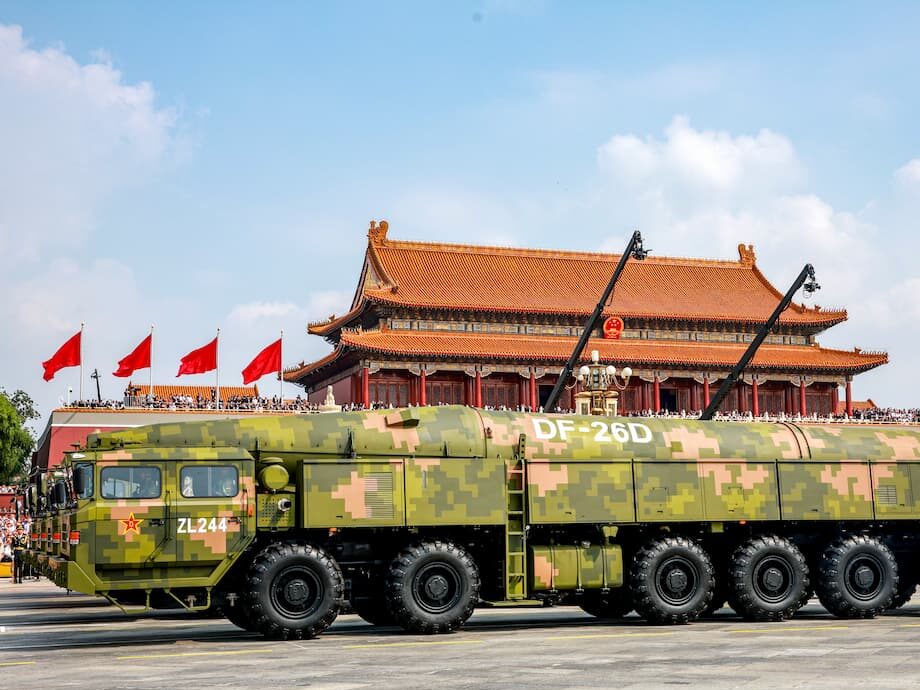A Pacific outpost on edge
Guam’s 170,000 residents live with periodic warnings about missiles, typhoons, and distant crises. That background hum grew louder after a military parade in Beijing showcased new weapons and the missile nicknamed the Guam Killer, while images of Xi Jinping alongside leaders from Russia, North Korea, and Iran added a sense of hardening alignments. The spectacle underscored the spotlight on Guam, a small island with outsized strategic value.
As a US territory and major hub for bombers, submarines, and Marines, the island sits at the center of any showdown over Taiwan. Strategists warn that in the opening hours of a conflict, China could try to blind, batter, and isolate Guam to slow the US response. Residents hear those warnings often, yet day-to-day life, the cost of living, and rebuilding after storms usually take priority until moments like this push security back to the front of conversation.
That worry is tied to the DF-26, an intermediate range ballistic missile with the reach to strike Guam from mainland China. Chinese outlets have called it the Guam Killer. The missile can carry either conventional explosives or a nuclear payload. Variants are intended to hit fixed bases on land and moving ships at sea. It travels at very high speed and can arrive with little warning.
A recent US Defense Intelligence Agency assessment said China is fielding more DF-26 launchers and is expanding both conventional and nuclear forces. The dual use design increases the risk of confusion in a crisis because the target cannot know what type of warhead is on the way. Pentagon analyses also point to a rapid increase in China’s total warheads over the next decade, which would add further weight to a missile force already built for quick movement and surprise.
The United States is racing to add an enhanced integrated air and missile defense for Guam, an effort priced between 1.5 and 1.7 billion dollars in near term funding and built out over several years. New launchers, radars, and command networks are already arriving, while construction continues on backup airfields and dispersal sites around the region. Washington wants the island to absorb an initial strike, keep operating, and contribute to a response if deterrence fails.
What is the Guam Killer and why it matters
The DF-26 is a road mobile, solid fuel missile that can be moved, hidden, and fired on short notice. Range figures cited in open sources span roughly 2,000 to more than 3,000 miles, enough to reach Guam, parts of Japan, and US naval forces operating well into the Philippine Sea. China has refined guidance, tracking, and communications to turn that range into real targeting power in the Pacific.
Range and payload
The missile family supports two broad missions. One version carries a guidance package and warhead intended for land targets such as runways, ports, fuel storage, and air defense nodes. Another version carries sensors and terminal guidance meant to strike large moving ships. The system can accept different warheads. That includes nuclear options and a range of conventional loads designed for cratering runways or smashing hardened structures.
Evolving variants and target set
Analysts describe upgrades, often labeled DF-26D, that seek greater accuracy and survivability through improved navigation, counter jamming, and decoys. Over water, a strike would rely on a broad kill chain that begins with satellites, long range radars, patrol aircraft, drones, and electronic intelligence. These sensors locate US groups, pass tracking data to missile units, and refine the aim mid flight. The result challenges carrier air wings and fixed bases alike.
This category of ballistic missile descends at high speed, which compresses decision time for defenders and complicates interception. China also deploys hypersonic glide vehicles that fly lower and maneuver, such as the DF-17 and DF-27, and anti ship missiles like the YJ-21. Together, these tools increase the number of angles and speeds that any defense must handle in the second island chain.
Guam in a Taiwan crisis
Guam anchors the second island chain and links US operations across the Pacific. Andersen Air Force Base can host heavy bombers, tankers, and fighters. Naval Base Guam supports submarines and logistics. The Marine Corps is building a base for about 5,000 Marines. In any Taiwan contingency, these assets would be central to air refueling, long range strikes, and resupply. Chinese planners know this and may try to suppress the island’s ability to launch and sustain operations.
Wargames and studies point to a first salvo aimed at slowing sortie generation by cratering runways and taxiways, damaging fuel systems, and disrupting command and control. A study that modeled repeated missile attacks with conservative assumptions found US fighter operations could be shut down for roughly 12 days in Japan and nearly two days in Guam. Runways for larger aircraft such as tankers could be closed in Japan for more than a month and for more than half a week in Guam. No single fix, whether dispersal, rapid runway repair, or missile defenses, fully removes this challenge.
The US answer mixes new technology and new concepts. Agile Combat Employment, known as ACE, aims to spread aircraft across smaller sites and move them often to complicate Chinese targeting. The US has invested in alternate runways on Tinian near Saipan, while Palau has invited new ports and airfields. The Philippines has expanded US access to northern sites that point toward Taiwan. These steps increase resilience, yet they also introduce logistics constraints because many locations lack hardened fuel, shelters, and stocks. Modern surveillance from space and air can still find and strike aircraft parked in the open.
The new shield being built on Guam
The Pentagon calls Guam the priority for a 360 degree integrated air and missile defense. Pieces of that shield are now on the island. The plan brings together the Aegis Combat System on land, Terminal High Altitude Area Defense (THAAD), Patriot batteries, the Army’s Indirect Fire Protection Capability (IFPC), and the Navy’s family of Standard Missiles. Launchers known as Mk 41 are being installed to fire interceptors that can counter ballistic missiles in space and defend against lower altitude threats. Future missiles in development seek to defeat hypersonic weapons during their glide phase.
Integrating sensors and shooters
At the core is a battle network that connects radars, infrared sensors, and launchers so that any sensor can cue any shooter. The Army’s Integrated Battle Command System, or IBCS, is designed to pull in data from Army, Navy, and Air Force sensors and present a single view to commanders. The goal is to detect and engage ballistic missiles that fly high, cruise missiles that fly low, and swarms of drones that can confuse defenses. The network must also survive attacks on satellites, jamming of communications, and cyber intrusions.
Magazine depth and reload
A determined attacker could launch many weapons from different directions and altitudes at once. Defenders need enough ready missiles to ride out a large salvo, and they must reload quickly under stress. IFPC is meant to give Guam more interceptors against cruise missiles and rockets and to support faster reloads than older systems. The services are also looking at adding AIM-120 air to air missiles on ground launchers to fill coverage gaps against fast cruise missiles. Regular live fire tests on Guam are planned, starting with Aegis this year and continuing with as many as two tests a year through the decade.
Local decision making is crucial because Guam sits far from Hawaii, where Indo Pacific Command is headquartered, and an inbound ballistic missile can arrive within minutes. New command and control arrangements are being built so that crews on the island can identify, decide, and shoot inside those short windows. Chinese doctrine also targets information networks. US planners are hardening cables, radios, and backup systems so that Guam does not get cut off.
Adm. Samuel Paparo, who leads US Indo Pacific Command, has summed up the stakes in direct language.
Defending Guam is my top priority.
Missile defenses do not promise a leak proof shield. Their job is to thin out an attack, keep key assets in the fight, and buy time for offensive forces to strike back. Even partial protection can shape an adversary’s calculus and reduce the scale of damage in the opening hours.
How prepared are civilians
Guam’s civil authorities are also planning for the worst case. In a recent tabletop drill, officials walked through a scenario where warning of inbound missiles arrived with only about six minutes to spare. In the scenario, impacts hit the Port Authority, Andersen Air Force Base, and the international airport despite military interceptors. Hospitals faced surges of injured residents. Emergency calls spiked as power faltered and communications went down. The exercise focused on coordination, public warning, search and rescue, logistics, and infrastructure recovery. Organizers expect an after action review within 90 days and a public report after 120 days.
Governor Lou Leon Guerrero has pushed to bundle plans into a single survival guide that families, schools, and businesses can use for any wartime crisis, including radiological hazards. Advisors stress that Guam’s threat level has not changed, yet they also point to recent missile exchanges in other regions as evidence that planning matters. Military defenses are designed first to protect forces. Local leaders say civil defense needs more investment so that the community can stay informed, shelter when needed, and recover faster.
Arms race across the islands
The focus on Guam fits a wider race across the Western Pacific. China is stepping farther into blue water with carrier groups operating beyond the first island chain and into the second. During one set of drills, Chinese ships and aircraft flew and sailed through areas watched closely by Japan and Australia. Beijing’s posture is matched by a surge of allied activity. The United States has brought a new medium range missile system called Typhon to Japan on a temporary basis. It has moved long range anti ship missiles into northern parts of the Philippines. Allied navies are working together in larger exercises, from the Philippines to Australia.
These moves are meant to complicate China’s ability to mass forces and to reassure partners. They also increase the number of missiles and sensors in a tight space. Chinese hypersonic systems like the DF-17 and DF-27 travel at more than five times the speed of sound and can maneuver in flight. That reduces warning time for ships and bases and makes interception harder. Some experts question claims that carriers can be sunk in minutes, and history suggests modern carriers are tough ships. The vulnerability is the flight deck and the aircraft that depend on it. If a carrier must operate far from the fight to stay safe, its aircraft will struggle to cover the distance to a fast moving battle.
How residents are coping
On Guam, daily life goes on. Residents worry about grocery prices, housing, and typhoon seasons. A display in Beijing or a new missile test can push concerns about war to the front of the mind, then recede again. Many islanders trust the US military to defend the island. Others look at the pace of Chinese missile deployments and at signs of closer ties among China, Russia, and North Korea and see a hardening security environment. Local officials urge calm and steady attention to practical steps, from family emergency plans to following official alerts.
What to Know
- China has showcased the DF-26, often called the Guam Killer, an intermediate range ballistic missile that can strike Guam from mainland China.
- US intelligence says China is expanding the number of DF-26 launchers and growing both conventional and nuclear forces, raising risks in a crisis.
- Washington is building an integrated air and missile defense on Guam that links Aegis, THAAD, Patriot, IFPC, and new launchers, with regular tests planned.
- Runway cratering from missile salvos could halt fighter operations for days and close runways for larger aircraft for longer periods, even with rapid repair.
- Local agencies ran a missile strike response exercise that assumed only six minutes of warning, with impacts on the port, air base, and airport.
- The US is dispersing forces through Agile Combat Employment and investing in alternate airfields on Tinian, with additional facilities planned in Palau and access expanded in the Philippines.
- The United States has deployed a Typhon missile system to Japan and positioned long range anti ship missiles in the Philippines.
- Chinese carrier groups are operating beyond the second island chain, while hypersonic systems reduce warning time and strain missile defenses.
- Adm. Samuel Paparo has stated that defending Guam is his top priority, reflecting the island’s central role in US planning.
- Residents balance everyday concerns with rising strategic anxiety, while officials emphasize practical preparedness and reliable public information.




